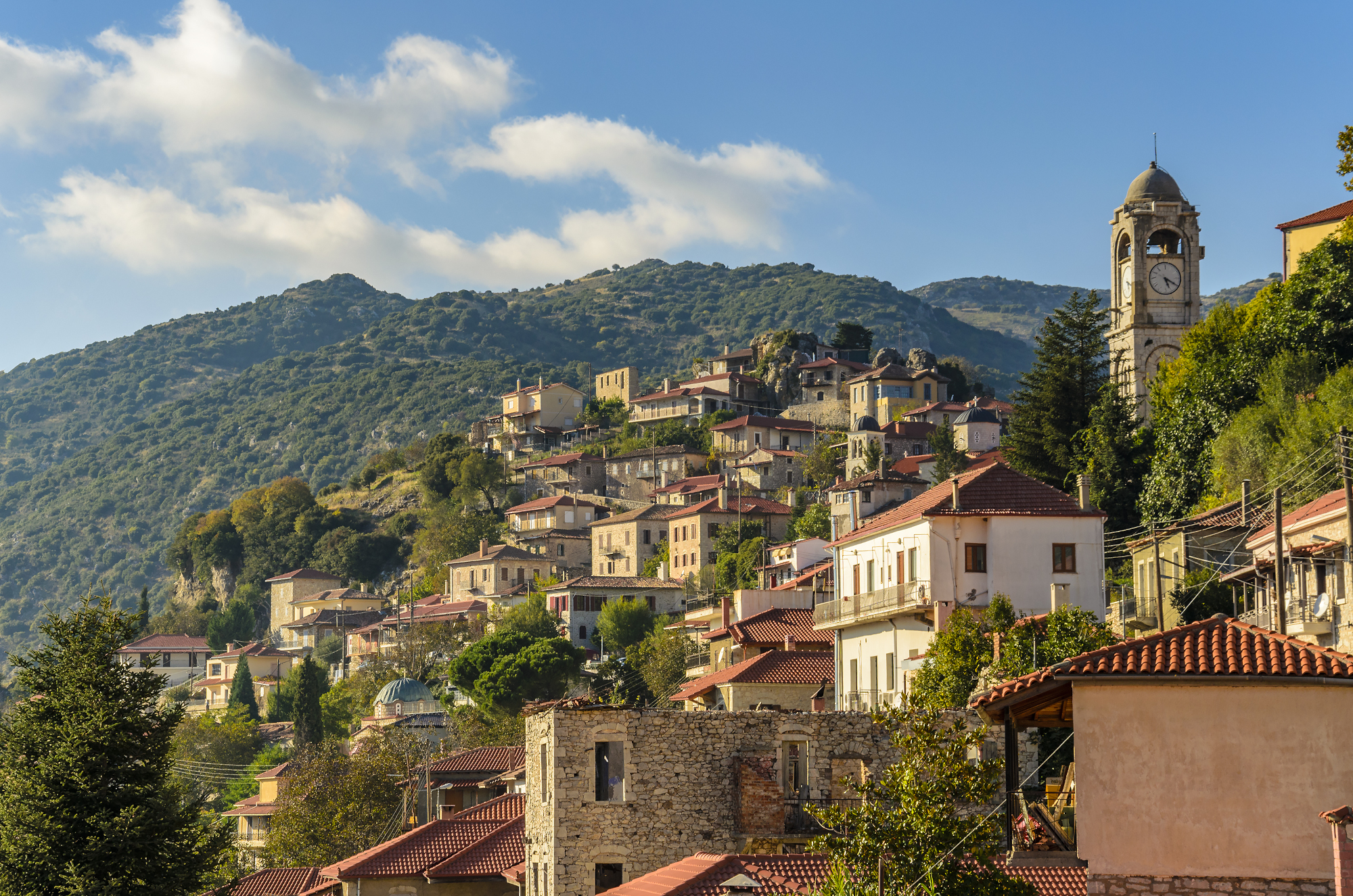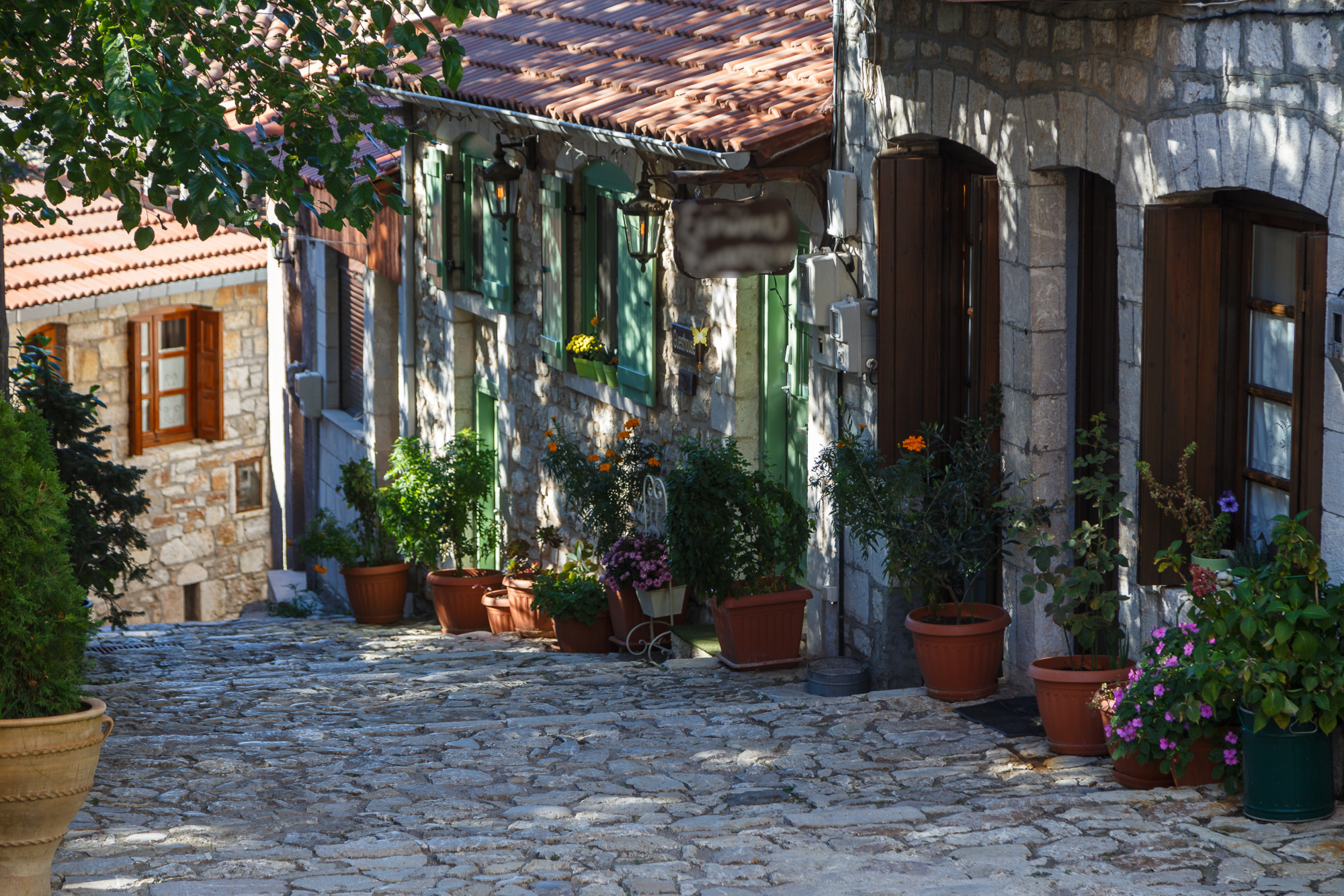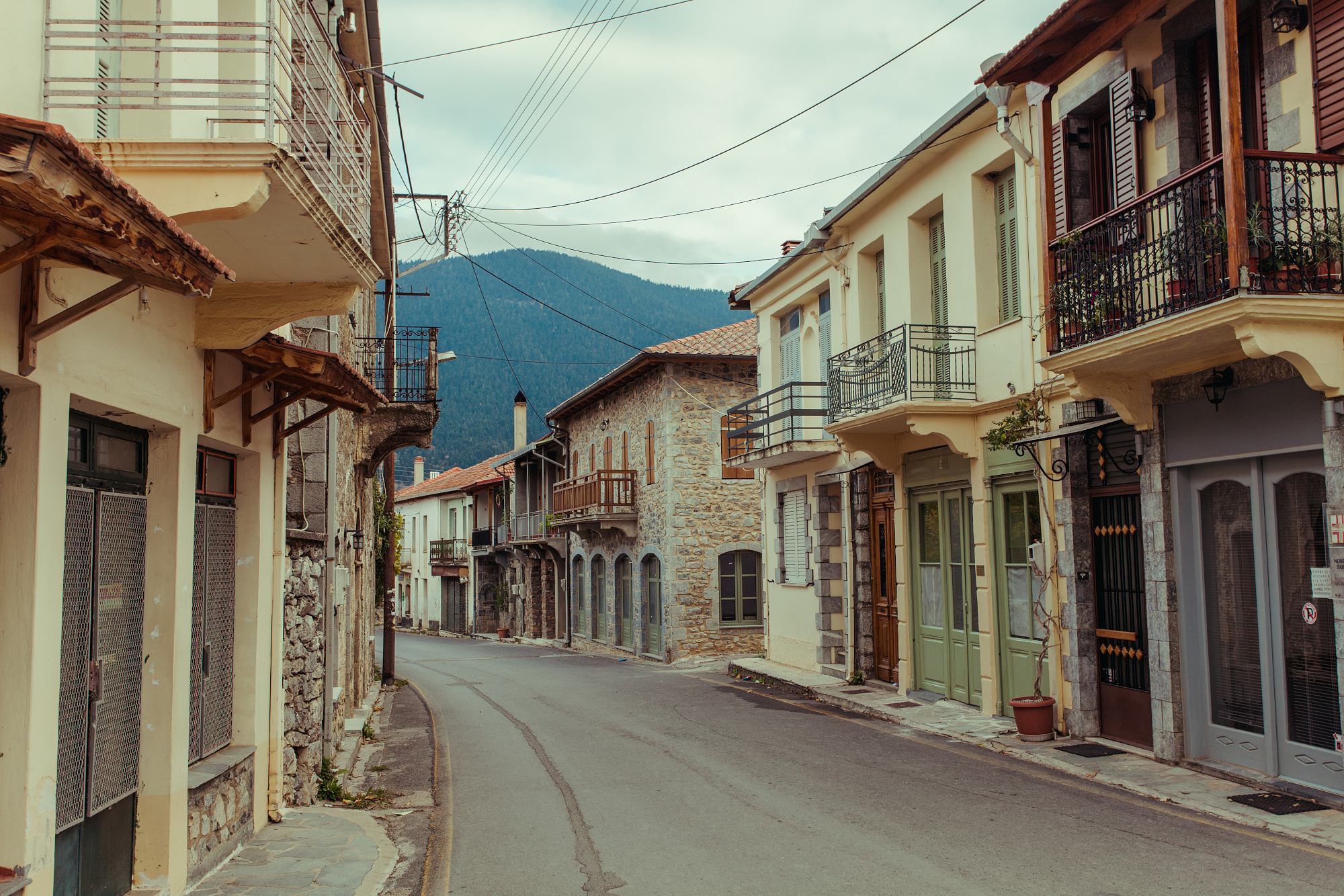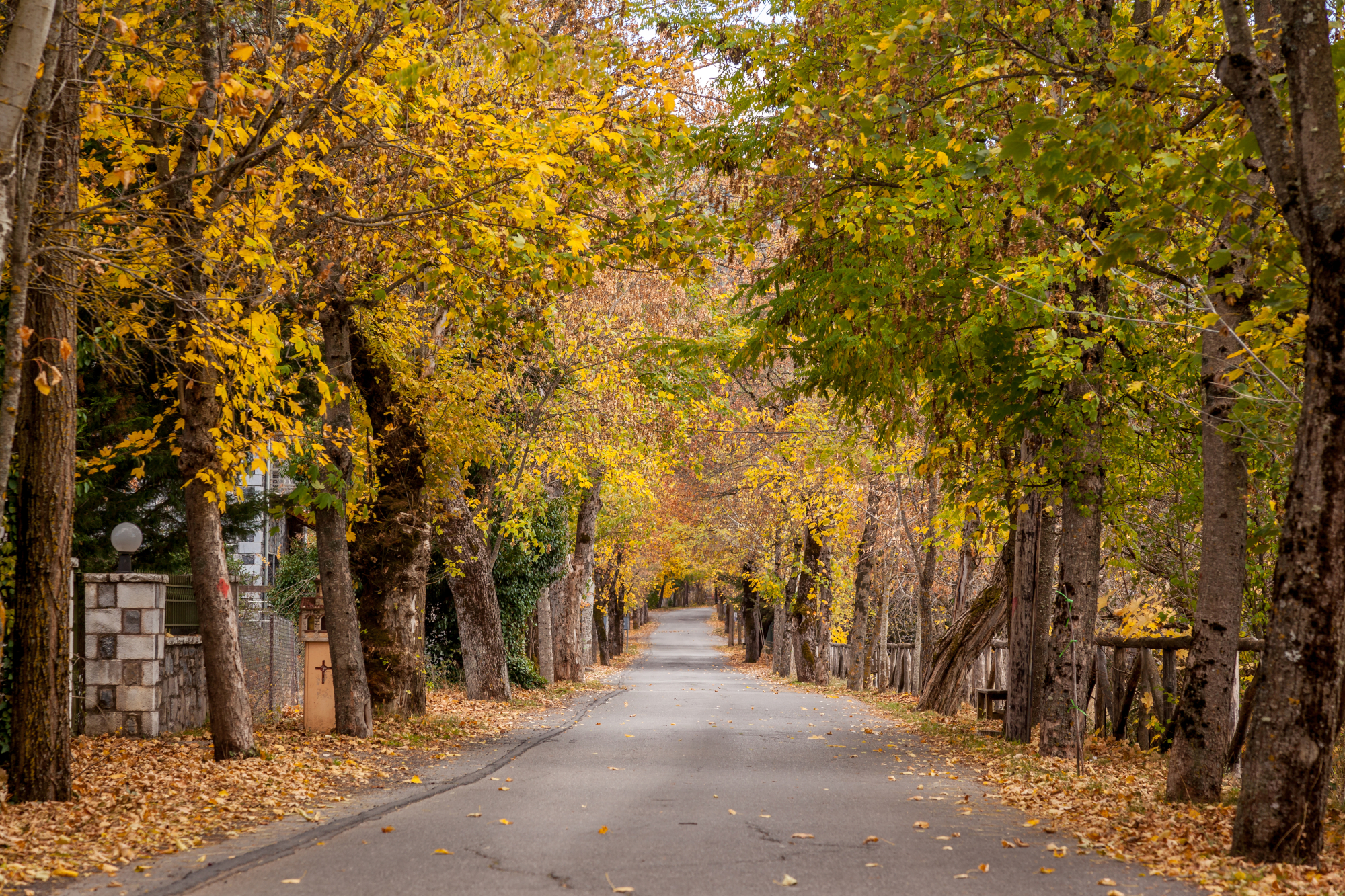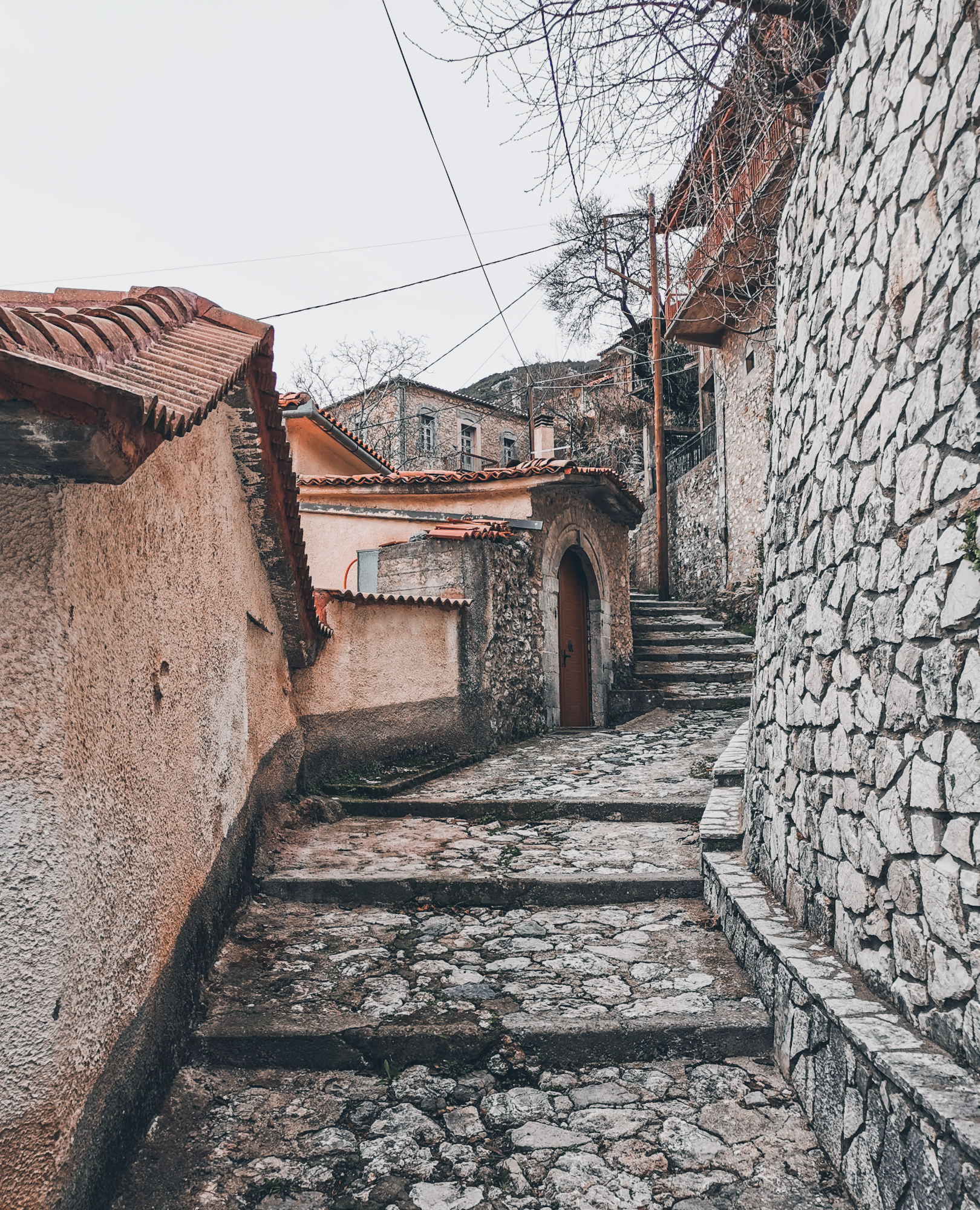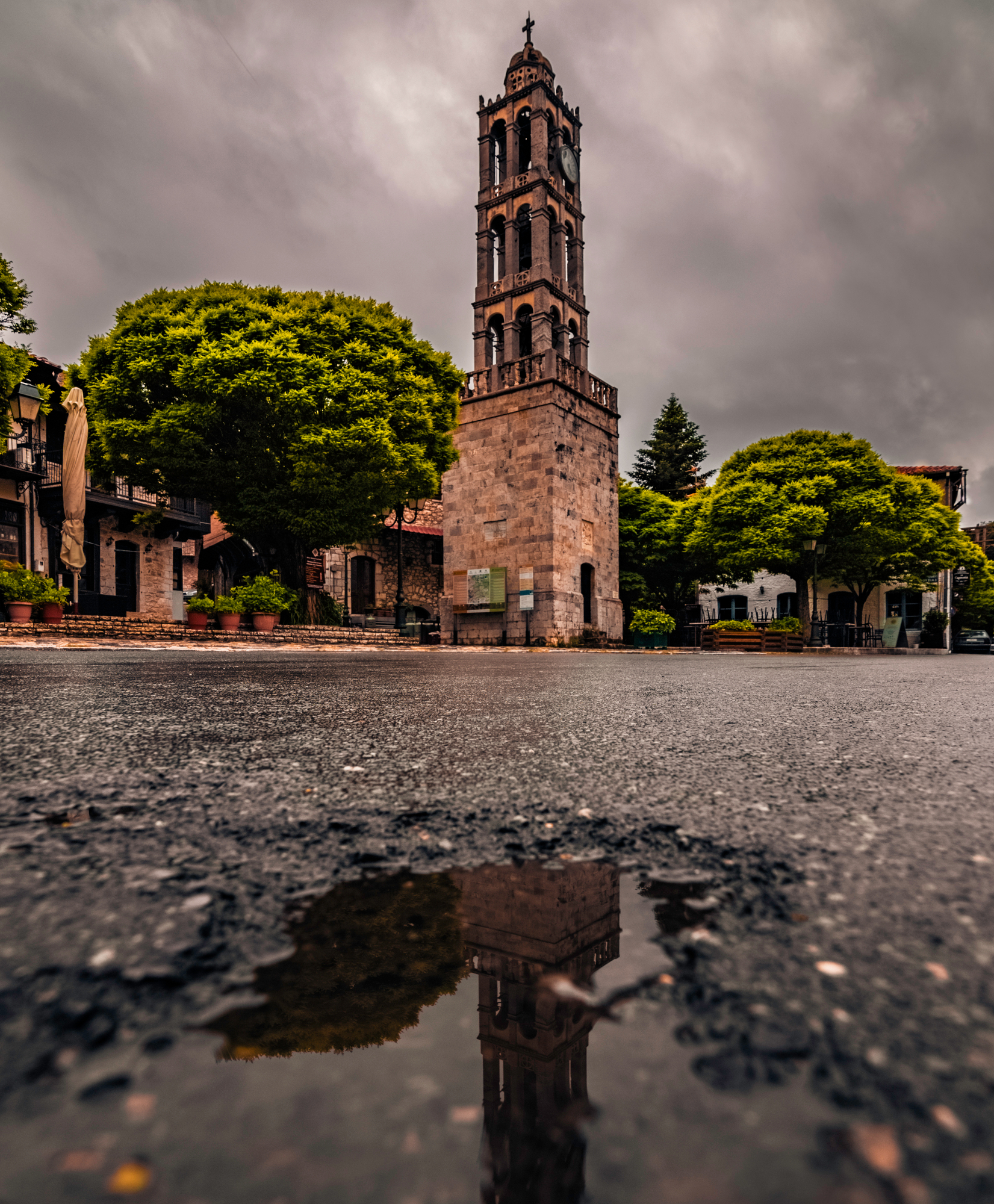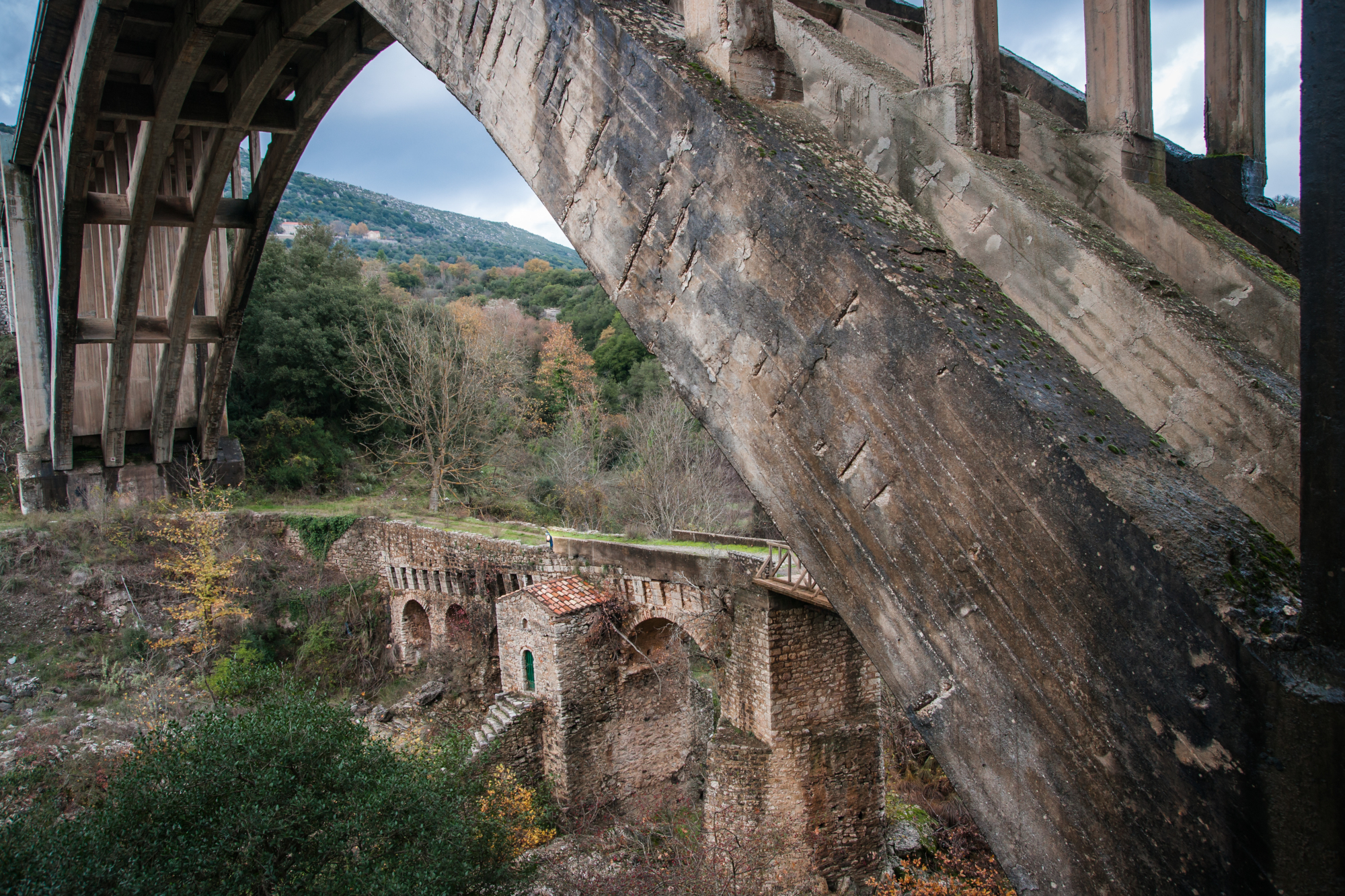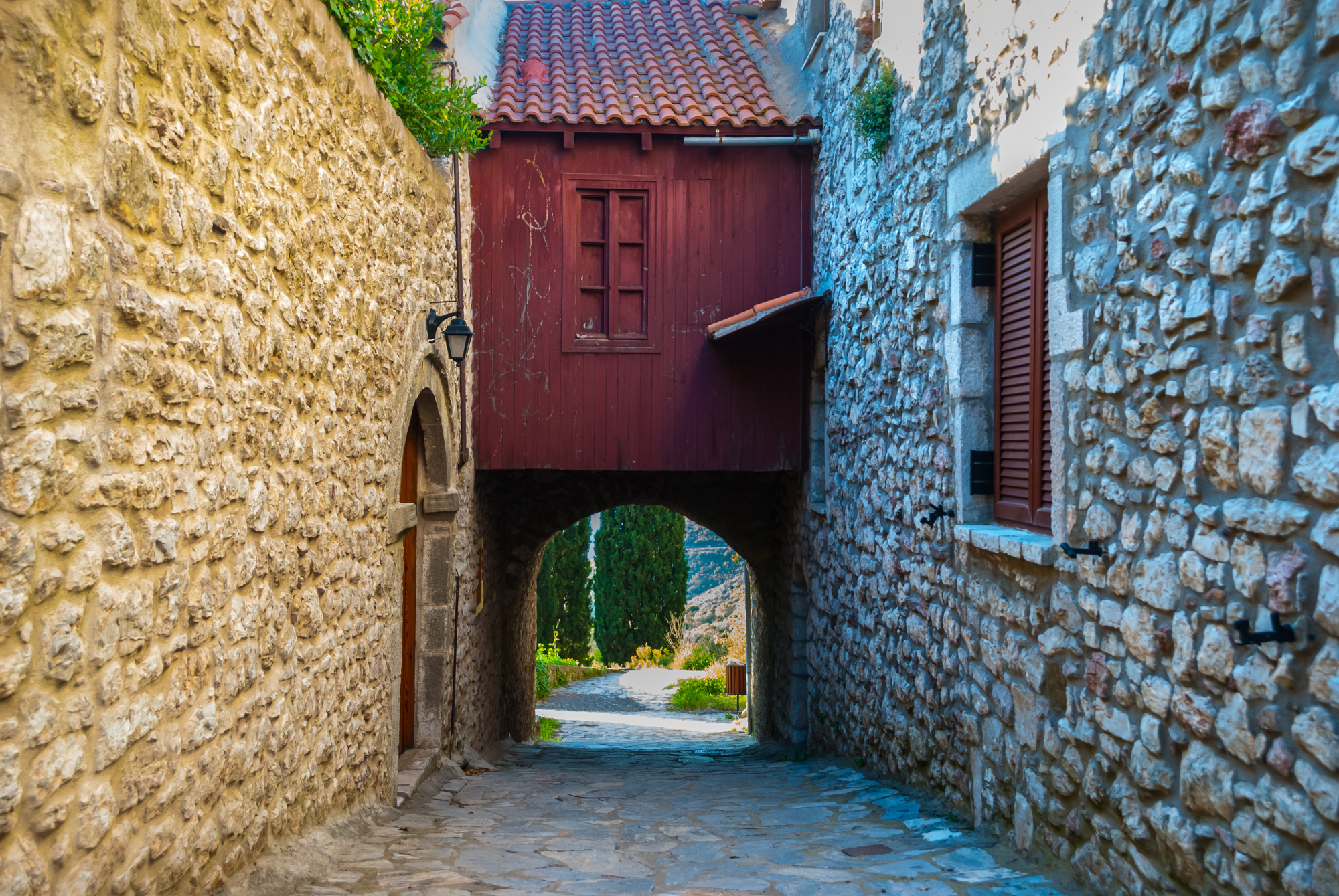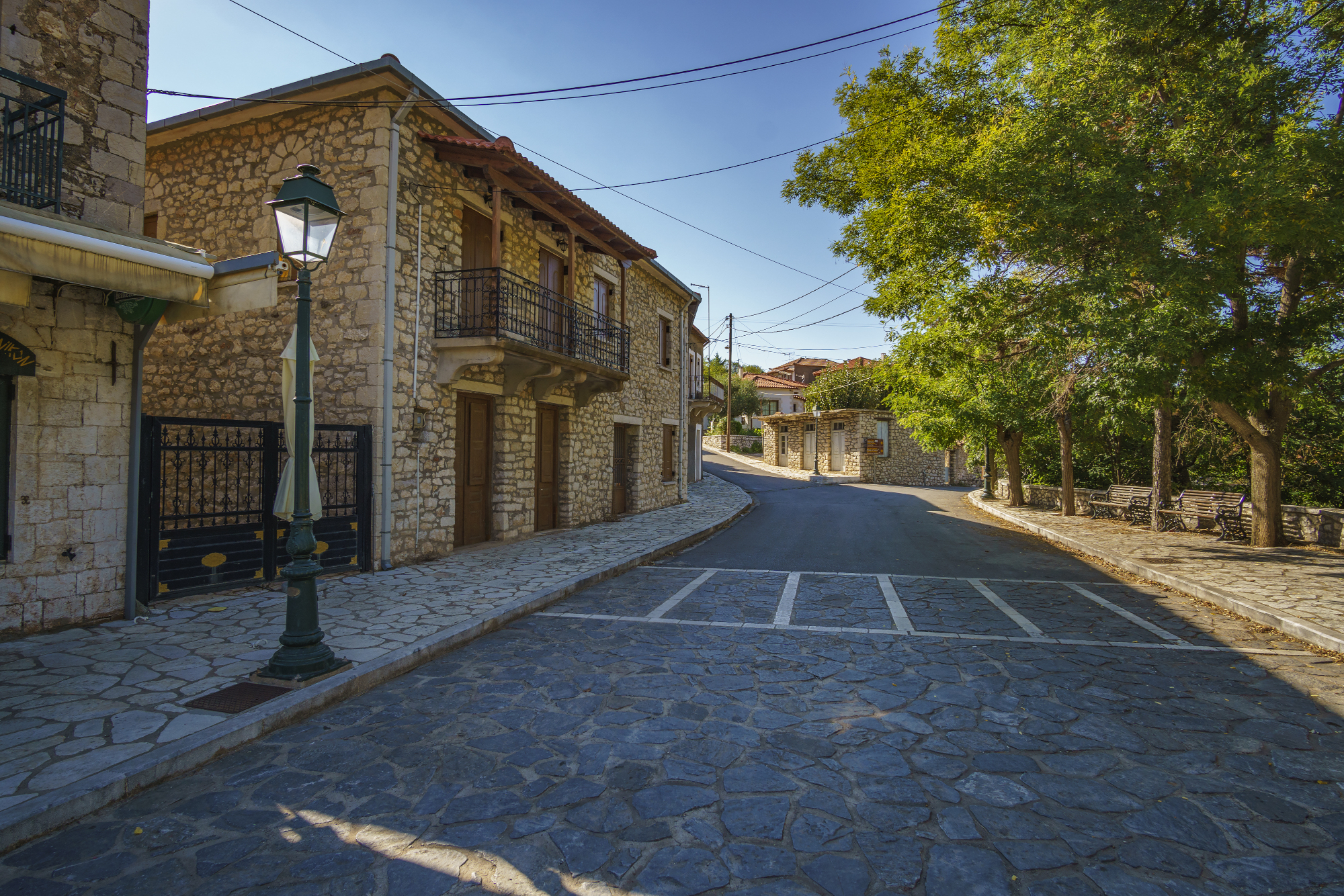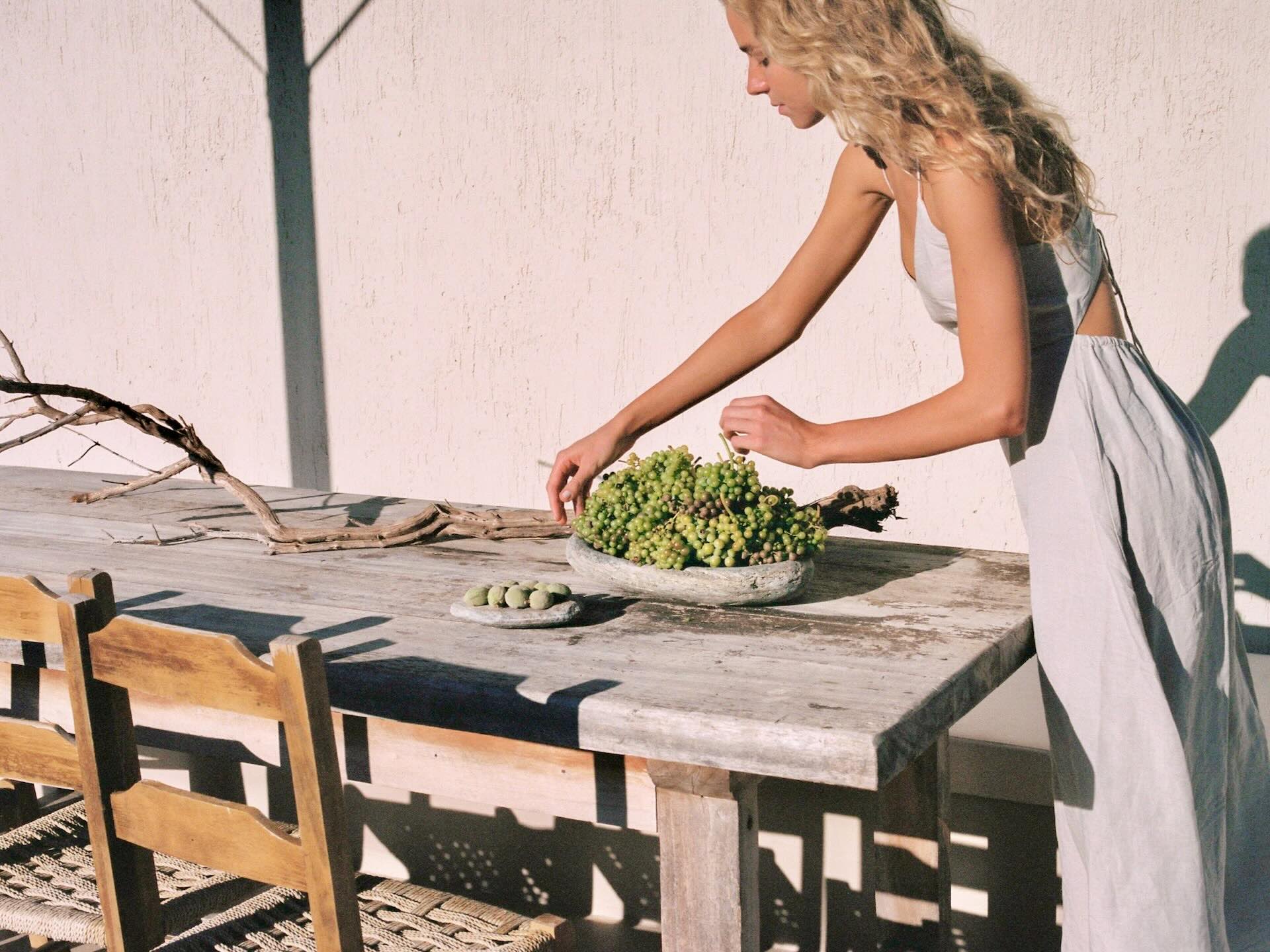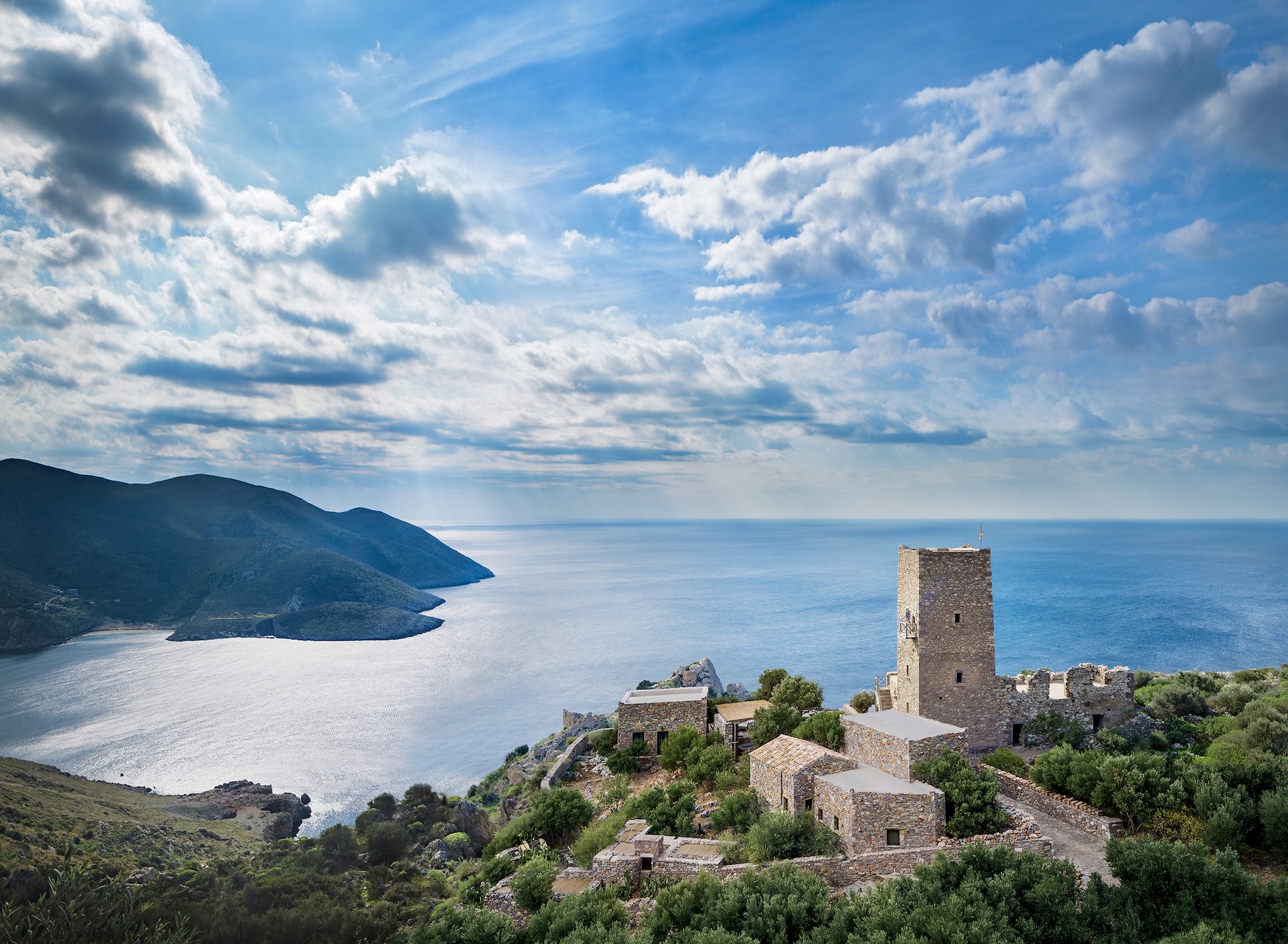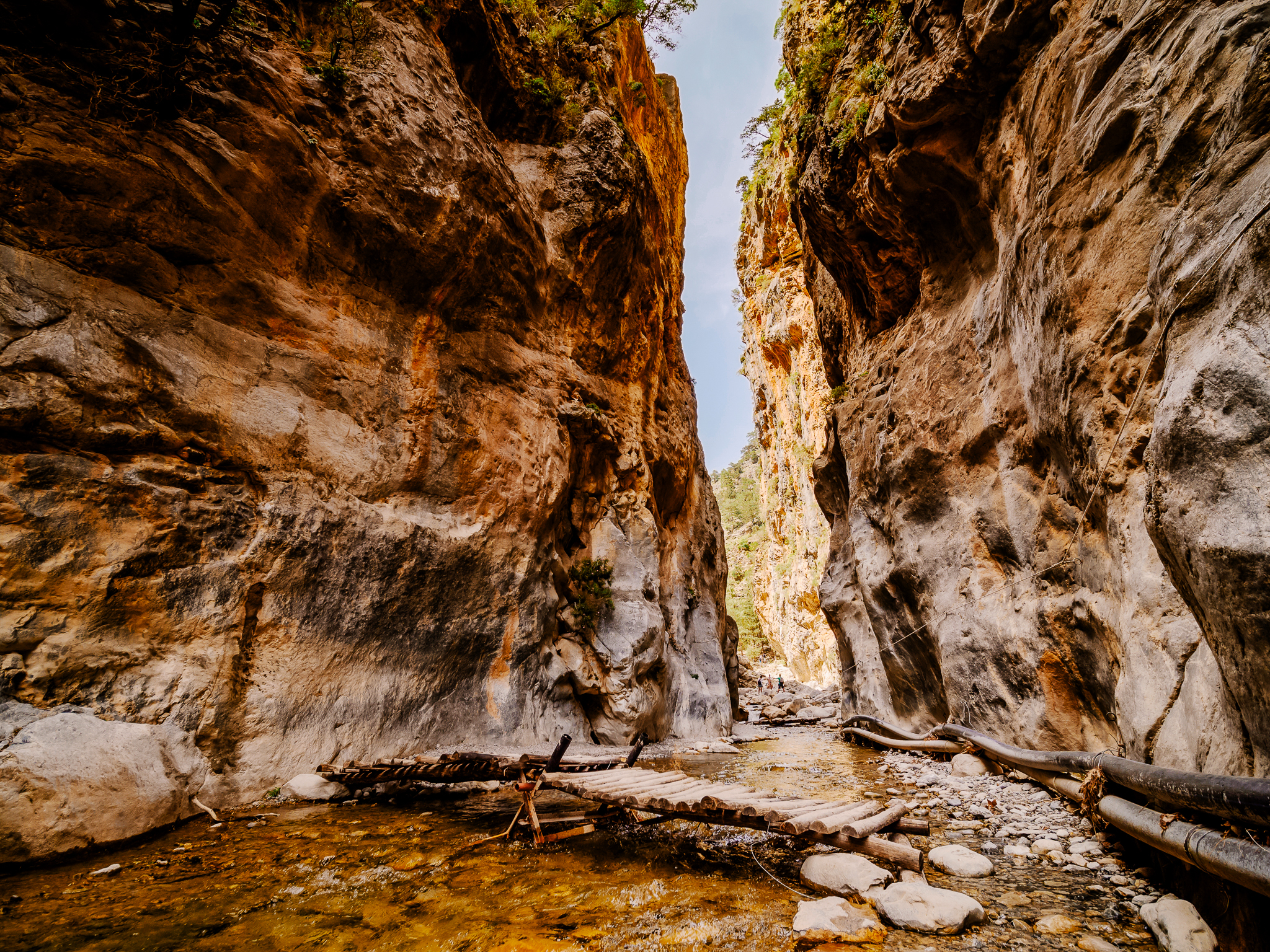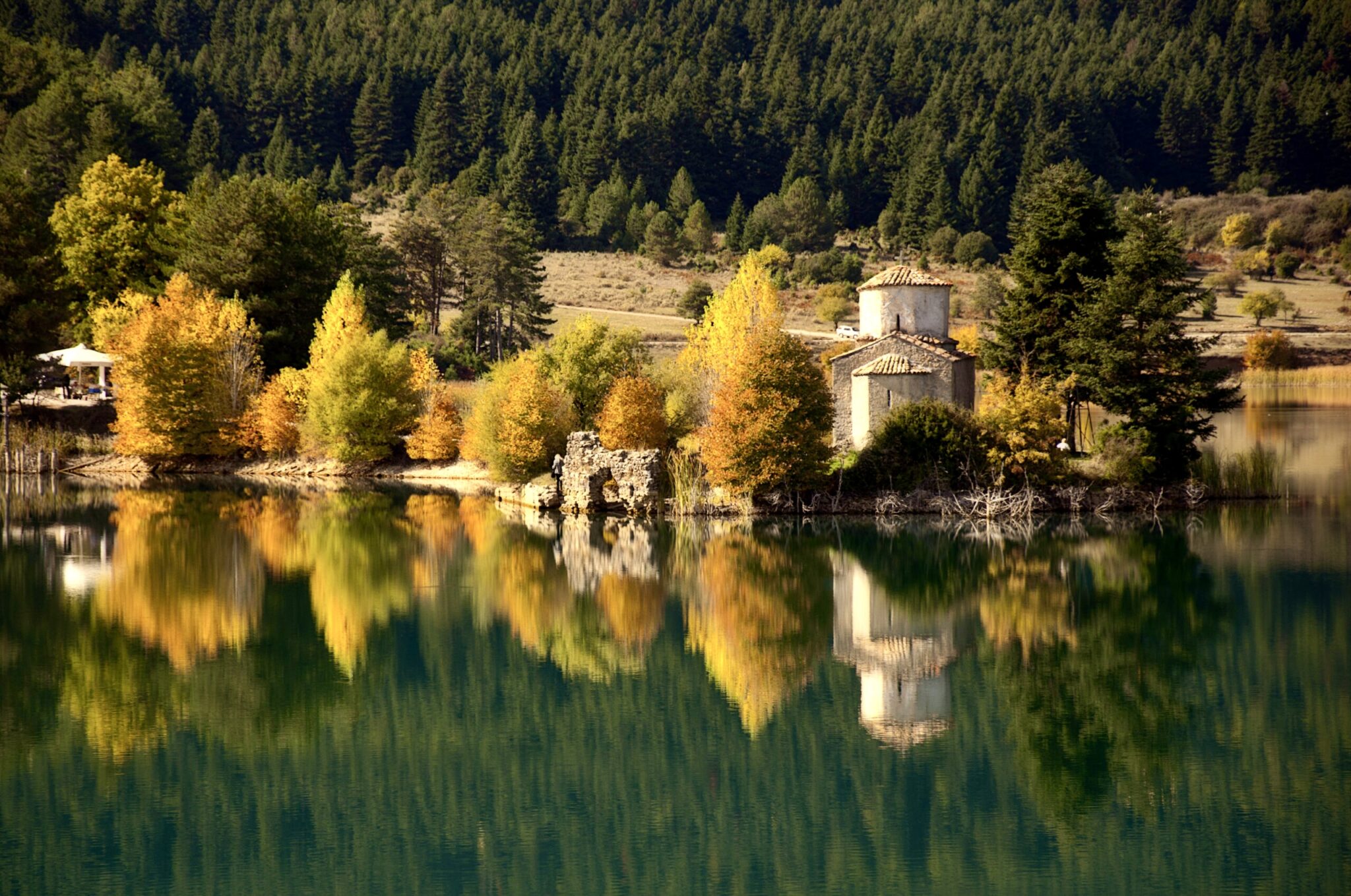Five villages, each one with its own style, cosmopolitan Dimitsana, mainstream and covered in fir trees Stemnitsa, medieval Karytaina and low profile Elliniko, are all beautiful and ideal for romantic weekends and sportive getaways in nature.
Dimitsana
Dimitsana, that was main source of gunpowder during the Greek War of Independence in 1821, has become one of the top destinations in Arcadia with romantic guesthouses and stylish cafés.
Built on a hill that’s almost 1.000 metres high, it overlooks part of the Loussios gorge and the mountaintops of Mainalo. It is a large village that flourished in the 16th century and later on, played an important role in the 1821 Revolution, providing gunpowder to the fighters. In 1978 it was declared a listed traditional settlement and it gradually became known as one of the most popular mountain destinations.
Dimitsana is one of the most picturesque and at the same time cosmopolitan villages in Arcadia and is gorgeous throughout the year. Autumn, however, when nature takes on bronze shades, and winter, when the fir tree forest becomes dark green, are its best seasons. You’ll reach it after about 2.5 hours’ drive, large part of which is through wonderful lush nature. You’ll stop at the village’s square, that may be small but has a great view of the Arcadian mountains’ slopes. You can catch your breath in one of the traditional coffee shops or cafés here and on the main road, Lampardopoulou, you’ll need this breath before you start exploring the village’s cobbled paths.
Being a listed traditional settlement, Dimitsana is full of two-storey stone-built houses with tiled roofs, some with the signs of time apparent on them, others new but completely abiding to the traditional style. Go up to the area ‘Kastro’, the Acropolis of the ancient town Teuthis, at the top of the village. Only a few parts of the walls remain, but the view is even better here: you’ll take in the mansions, the fir trees and the elaborate bell towers. As you walk back down, you should stop at the historic Library that houses 35.000 volumes, many of which are rare books, patriarchal sigillia and firmans from the Sultan. The Library also houses the larnax with the remains of Germanos III of Old Patras and a varied folklore collection. Also stop at the Ecclesiastical Museum that is housed in the house of Gregory V the Ecumenical Patriarch of Constantinople.
Get to the old Moustafa fountain at the entrance of the village and also to the bridge of Katovrisi at the other side. The clock of Agia Kiriaki church is also worth noticing as it came a long way to the village; it was a present from New York Dimitsanitans, while the stone clock tower was created by sculptors from Tinos. It arrived at the village around 1900, while the bell, that weighs 700 kg, arrived a decade later, again from America. Outside the village, around 2 kms away, you can find the Open-air Water Power Museum that you can easily walk to. Here you’ll discover how the older generations used the power of water to make flour and gunpowder, to process leather etc. If you enjoy hiking, the trails to the Loussios gorge start here. Dimitsana is not just cute cafés and romantic guesthouses, it’s also a very good base for a series of activities like hiking by the river, rafting, canoeing, kayaking, climbing, driving on 4×4 trails, mountain biking, skying in Mainalos etc.
The Menalon Trail social enterprise has mapped 75 km of trails that have been certified by the European Ramblers’ Association (ERA). If you want to go on a short hike then choose the trail that leads to Zygovisti, an accessible cobblestone path that goes through old threshing floors and takes around 2 hours to complete. If you’re more hard core then head to Stemnitsa on a trail that takes around 5 hours to complete. The route is unique as a large part of it goes through the gorge of Loussios, and apart from the wonderful nature you’ll come across stone founts, bridges etc. Another lovely trail in nature is the one that goes to the Philosophou monastery that was built in 963. The School of Dimitsana was housed there as well as the ‘krifo scholio’ (secret school – during the Ottoman rule, it was a supposed underground school where children were taught the Greek language and the Christian doctrine) while on the other side of the gorge is the Timiou Prodromou monastery, built on a rock, hardly discernible, with a breath-taking view. Whichever trail you choose to take, make sure you have the right gear. You can also approach any of these locations by car and then walk a short distance in the gorge.
Accommodation
Amanites Guesthouse: a beautiful guesthouse in a building that has been around for more than 150 years. Comfortable and extremely well-kept rooms. (2795031090)
Theonimphi Guesthouse: neat guesthouse in an 1850 renovated building, with light décor and a fireplace in every room. (2795029215)
Kazakou Guesthouse: a traditional guesthouse with a warm atmosphere. (2795031660)
Food
Drimonas: a stone-built tavern at the edge of the village on the road to Stemnitsa, mainly serving casserole dishes and grilled meats. (2795031116)
Ta Pano Kato: café – bistro with a lovely décor that serves desserts and honest food. (6932336442) *Opens on the 2nd weekend in October.
To Steki tis Gefsis: a tavern in the village square, it serves casserole dishes but also skewered meats cooked over an open fire. (2795031424)
Vytina
The mainstream village of Arcadia. For endless coffees at the big square, beef in tomato sauce with hilopites (traditional Greek pasta in the shape of small squares) and, of course, great lamb chops, it’s ideal even for a daytrip.
One of the most famous villages in Arcadia, Vytina is known for its traditional style, its green, and its good meat. It’s built at a 1033 m. altitude on the fringes of Mainalos, and in the winter many Greek visitors come here for a weekend in nature. The church of Agios Tryfonas, built in 1846, is in the centre of the village, and is the tireless guard of Vytina and definitely worth a visit, as is the Folklore Museum, also in the square, with agriculture, logging and farming tools, looms, costumes, photographs etc. A coffee in the square to relax and gaze at the view is the most idle thing you can do, but if you’re more active you can explore the area’s beauty, near and far, by taking a walk down the tree lined ‘Path of Love’ with the maple trees and the plane trees, where the youth of Vytina in the past used to stroll and meet their husbands and wives for the first time, or in the little grove just a few minutes away that is perfect for a shaded walk and a mini picnic. The location of Vytina makes it an ideal base for exploring the area and engaging in other nature activities, from skying on Mainalo mountain to hiking on the Menalon Trail, to rafting on Loussios river. One thing is certain, whatever you choose you’ll enjoy it to the max.
The trail from Vytina to Elati, whose largest part is through the gorge of Mylaontas river, takes around 2,5 hours to complete and is gorgeous. Running waters, stone-built founts, watermills, stone bridges and a lot of pristine nature are the trail’s characteristics, while if you have the right equipment you can also climb to Mainalo’s refuge, where the firs become less dense and the mountain from lush gradually becomes bare. An excellent drive or hike is the one to Sphyridas hermitage, built on the rocks. Don’t miss a visit to the monastery of Kernitsa next to Mylaontas river, an imposing complex built within the trees with a stunning view of the Mylaontas canyon. It’s considered the oldest monastery in Arcadia, dating back around 9 centuries. Don’t leave Vytina without buying dairy products (cheese and yogurt), honey, walnuts and a souvenir wood sculpture made by the local artisans that have a long tradition in this art.
Accommodation
Arhontiko Nikolopoulou: a beautiful stone guesthouse with classic decoration. (2795022274)
Grand Vityna: ideal for families, it offers a variety of rooms all of them equipped with kitchenettes. (2795022977)
Mylaon Boutique Hotel & Spa: it offers suites with fireplaces that can host 2 to 6 people, it also has an indoor pool and spa facilities. (2795022298)
Food
To Tsipouradiko tou Panteli: a tavern with a large space with a fireplace and delicious mezes. (2795022683)
Ta Kokkina Pitharia: a well-kept tavern that serves mainly traditional dishes. In addition, they also serve game meat. (2795029030)
Stemnitsa
The noble village of Arcadia that has set its own course in silver and goldsmithing, gave birth to skilled merchants, has produced at least one shipowner, and continues to maintain its glory by aiming at the ‘right’ kind of tourism.
The Slavic name Stemnitsa means “shaded, wooded land” and it couldn’t describe the place better as it’s surrounded by acacia trees, plane trees, walnuts, chestnuts, cherries, firs and other trees, a fact that makes this noble village in Tripoli unique. It’s built at a 1.100 m. altitude and it’s truly gorgeous. Simple, ‘austere’ stone mansions, cobbled paths, founts. Whichever street you choose will not disappoint. Stemnitsa is beauty incarnate. The square is undoubtedly the liveliest part of the village, full of traditional coffee shops and taverns, it’s the meeting point for locals and passers-by and you must definitely have a coffee while you chat with the village’s elders, they are the land’s history and they will tell you a lot of things about Stemnitsa’s tradition in metallurgy and silversmithing – there is also a School of Silversmithery and Goldsmithery in the village, while there are also workshops and shops selling handmade jewellery –, about how good merchants the locals were, and about the Martinos shipowner family’s ancestry from the village.
Your strolls around the village must include Water’s Mother (Mana tou Nerou), that is the spring that gives water to the village and also has a good view. Also, the Palamideika neighbourhood is one of the most beautiful neighbourhoods in the village, and the folklore museum that includes costumes, post-Byzantine icons, wood sculptures, ecclesiastical objects, as well as everyday objects etc. For a panoramic view of the village and also of the wider area follow the cobbled street from the square and go to the ‘Kastro’ location where the medieval castle used to be, and where the church of Panagia Mpafero, built in the 12th century is. Another short walk is that to the Zoodochos Pigi monastery overlooking the village, while for a more demanding hike, follow the Menalon Trail that leads to Dimitsana through the Loussios gorge. If you are more experienced, and given that you have the right equipment, you can reach Αncient Gortyn on the banks of Loussios river, one of the most important Arcadian towns that reached its peak in the 4th century BC, while the first findings date back to the Late Helladic and geometric period. If you like cycling, rafting, canoeing, and kayaking this area is perfect for such activities, while there are various companies offering them.
In terms of gastronomy, you need to try the ‘migdalata’, the Stemnitsa version of skaltsounia (almond based sweet).
Accommodation
Stemnitsa Guesthouse: wooden ceilings, classic décor, spacious rooms and a cute garden. (2795081349)
Kanto’s Guesthouse: a unique guesthouse that uses traditional elements in a beautiful way. (6984611094)
Beleiko: a traditional guesthouse with a lovely view of the village and rooms with (2795081286)
Food
I Gerousia: a traditional tavern using fresh ingredients, offering refined flavours. (2795081253)
Stemnitsa: a cute tavern with outdoor seating, serving simple, well-prepared flavours. (2795081371)
Karytaina: The place where the medieval atmosphere is perfectly matched to rafting on Alfeios river and rappelling off a bridge.
Perched on the slope of a 582 m. high rock on top of which there is a 13th century Frankish castle, Karytaina is slightly different from the rest of the Arcadian villages, as the passing of the Franks has given a medieval vibe to the village. Narrow alleys, old stone houses, a few arcades and canopies at every step is the setting of Karytaina, a beautiful mixture of Frankish, Byzantine. and traditional architecture.
The landscape is also very impressive, as the surrounding nature is wonderful; pines, planes, acacias in copses are everywhere around the village, while at its fringes, Loussios and Alfeios river meet. As far as the view is concerned, it reaches the valley of Megalopoli.
To get to know the village you must be prepared to walk as it’s the best way to explore. Start at the medieval castle that overlooks the whole area and is built with materials from Ancient Vrenthi that used to be in the same location. It’s 110 metres long and over 40 metres wide, while the walls are over 7 metres high and 2 metres thick. Continue by choosing one of Karytaina’s narrow alleys and enjoy the stone mansions that stand tall in the passing of time. Before you leave the village to explore the outskirts there are some churches that need your attention, like the church of Zoodochos Pigi, built between the 14th and 15th century, with the unique bell tower with the Frankish elements, the beautiful Byzantine church of Agios Nikolaos, surrounded by tall cypresses and the beautiful murals inside, and also the church of the Evangelismos tis Theotokou (Annunciation of Our Lady) in the centre of the village where Kolokotronis’ bible, printed in 1811, is kept.
As soon as you’re done exploring within the village, it’s time to discover the beauties outside of it. Walk from the village towards Megalopoli to admire the Frankish arched stone bridge of Alfeios, built in 13th century that connected the Castle town of Karytaina to Messinia. Attached to the bridge is a small, Byzantine stone church of the Gennisi tis Theotokou (Virgin Mary’s birth), while right above it is the much larger, modern bridge – off which you can rappel to the base of the old bridge, inches away from Alfeios’ cold waters – there used to be many water mills in the area whose remains still stand today. The older people might remember this old bridge on the five thousand drachma note. Another special bridge is the Koukos bridge that is on the narrowest point of Alfeios on the ‘Tria Alonia’ Vlachorraptis location, that used to connect the region of Olympia with the villages of Gortynia, the bridge is 34 m. high, 20 m. long and 4 m. wide, and it’s very impressive how they managed to build it at this height.
A longer trail that needs better endurance is the one to Lykaio Mountain and Zeus’ temple, with a stunning view towards the mountain range of Arcadia and the valley of Megalopoli, and of course the foothills of the mountain towards Ancient Lykosoura, the first town to be bathed in the light of the sun according to Pausanias that can also be approached by car. For those of you who need more than hiking and drives, there’s also the option of rafting, canoeing and kayaking on Alfeios river, mountain biking, driving on 4×4 trails, and rappelling off the Karytaina bridge.
Accommodation
Petra Thea Villa Karitaina: a stone house with neat décor that can accommodate up to 6 people. (6908344604)
Pelasgos: a hotel with spacious, classically decorated rooms with fireplaces. (2791031490)
Vrenthi Guesthouse: a well-kept stone guesthouse with double and triple rooms and also an apartment for larger groups. (2791031650)
Food
To Kastro: a spacious room with a fireplace, with grilled meats and casserole dishes on the menu. (2791031113)
Stavrodromi: grilled meats and carefully prepared casserole dishes. (2 km from the village, 2791031284)
Elliniko
Lazy coffee breaks, carefree walks and maximum relaxation.
A clean, ‘neat’ village and one of the quietest mountain destinations in Arcadia, Elliniko is ideal for relaxed and restful weekends. It’s between Stemnitsa and Karytaina at 720 m. altitude and is full of two-storey stone-built mansions and also simple little houses, all of them neat and well-kept, with cobbled paths connecting the neighbourhoods. It’s a flatter village compared to the other four villages, surrounded by plane trees, mulberry trees, pine trees etc. You won’t come to Elliniko for the view, the stylish guesthouses and the nice cafés, you’ll come for the calm, lonely strolls in its streets, for the chats with the locals at the traditional coffee shops while you drink a glass of tsipouro (traditional pomace raki) and for the perfect relaxation. One of the most imposing buildings in the village is the old school built in 1932 near the square, but also its cathedral church of Profitis Ilias that was completed in the same year, while since 2009 there is also an Ecclesiastical Museum in the village with vestments, ecclesiastical objects, icons etc. A beautiful and relaxed walk outside the village is the one to the wells, ideally, take a coffee to go and sit on the bench to enjoy nature’s quiet.
Elliniko, very close to the Loussios gorge, is perfect for relaxed hikes and more difficult trails in the calm fresh green nature.
Don’t forget to visit Ancient Gortyn on the banks of the river, as well as the Temple of Asclepius nearby. At the same spot there are remains of thermal baths – which could accommodate 30 patients at the same time – whose heating system is exemplary and of ‘advanced’ technology compared to later Roman baths. The Kokkoris stone bridge is a stone’s throw away, while steps away from the archaeological site you’ll find the small stone church of Agios Andreas that is a must see.
Accommodation
Elafos Spa Hotel: it has 7 rooms, each with different décor, and also a sauna, jacuzzi and a hammam. (2791031600)
Gortys Guesthouse: an elegant, atmospheric guesthouse with cosy rooms with fireplaces. (2791031040)
Food
Georgantas: a well-kept tavern with good casserole dishes and grilled meats prepared at the time of order. (2791031009)



